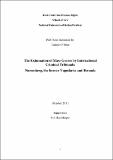| dc.contributor.advisor | Murphy, Ray | |
| dc.contributor.author | O'Brien, Eadaoin | |
| dc.date.accessioned | 2012-05-03T11:19:24Z | |
| dc.date.available | 2015-01-23T15:51:27Z | |
| dc.date.issued | 2011-10-28 | |
| dc.identifier.uri | http://hdl.handle.net/10379/2718 | |
| dc.description.abstract | This thesis is a study on the practice of mass grave exhumation in the context of international criminal law, and more specifically as employed by international criminal tribunals. The primary institutions of focus are the International Military Tribunal held in Nuremberg, the International Criminal Tribunal for the former Yugoslavia and the International Criminal Tribunal for Rwanda. The study locates the genesis of the phenomenon of mass grave exhumation for international criminal justice purposes at a historical point in time, contending that the emergence of this experience parallels with the development of international criminal law during and after the Second World War, and with the growing movement against impunity for the most serious of international crimes. It is argued that this process represents a shift in how the remains of the deceased in armed conflict are viewed.
The legal framework relevant to the treatment of the dead in war is outlined in Chapter I and the relevance of rules of international humanitarian law pertaining to the deceased to forensic exhumations is discussed in the first chapter. The core aim of Chapter II is to detail the modus operandi of mass grave exhumations from an international criminal justice perspective. Chapter III examines the presentation of forensic evidence at the International Military Tribunal held in Nuremberg in 1945 and 1946. The second half of the chapter explores the crime of enforced disappearance and explains how the practice of forensic exhumation, in an international criminal justice context, re-emerged after a four decade long interval between the close of the Second World War and the growing movement against impunity that emerged in the Southern American cone in the 1980s. Thus, Chapter III places the work of the ad hoc Tribunals, vis-à-vis forensic investigations, into a historical context. The fourth Chapter explores the dynamics of the forensic programme at the International Criminal Tribunal for the former Yugoslavia, whilst Chapter V examines the forensic programme operated on behalf of the International Criminal Tribunal for Rwanda. A further core question that arises in the study of mass grave exhumations is whether the practice of forensic exhumation of the graves of victims killed during armed conflict, for the purposes of criminal justice, can be viewed as problematic or undesirable in some circumstances. This issue explored in the final Section Chapter V, which examines the question of why forensic evidence was not relied upon more extensively at the International Criminal Tribunal for Rwanda. | en_US |
| dc.rights | Attribution-NonCommercial-NoDerivs 3.0 Ireland | |
| dc.rights.uri | https://creativecommons.org/licenses/by-nc-nd/3.0/ie/ | |
| dc.subject | International human rights law | en_US |
| dc.subject | International humanitarian law | en_US |
| dc.subject | International criminal law | en_US |
| dc.subject | Transitional justice | en_US |
| dc.subject | Forensic science | en_US |
| dc.subject | Forensic anthropology | en_US |
| dc.subject | Forensic archaeology | en_US |
| dc.subject | Nuremberg trial | en_US |
| dc.subject | Yugoslavia | en_US |
| dc.subject | Rwanda | en_US |
| dc.subject | Human Rights | en_US |
| dc.title | The Exhumation of Mass Graves by International Criminal Tribunals: Nuremberg, the former Yugoslavia and Rwanda | en_US |
| dc.type | Thesis | en_US |
| dc.contributor.funder | Irish Research Council for the Humanities and Social Sciences | en_US |
| dc.local.note | This thesis is a study on the practice of mass grave exhumation in the context of international criminal law, specifically as employed by international criminal tribunals. A number of case studies are examined in detail, namely the Nuremberg Tribunal and the International Criminal Tribunals for the former Yugoslavia and Rwanda. | en_US |
| dc.local.final | Yes | en_US |
| nui.item.downloads | 11247 | |


